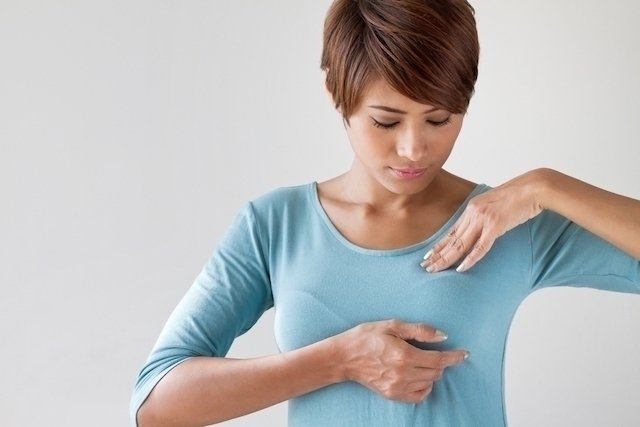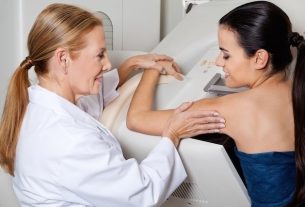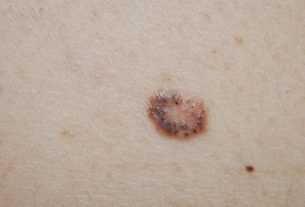The main symptoms of breast cancer are the appearance of a nodule or lump in the breast that does not hurt, change in the color of the nipple, fluid leaking from the nipple, appearance of lumps in the armpit, itching in the breast or nipple and the presence of a groove in the breast. .
These symptoms may appear simultaneously or separately, and may be symptoms of early or advanced breast cancer. Furthermore, the presence of any of these symptoms does not necessarily mean the existence of breast cancer, but you should consult a breast specialist, as it could be a benign nodule or an inflammation of the breast tissue, which requires treatment. See which tests confirm breast cancer.
Breast cancer symptoms
The main symptoms of breast cancer are:
- Presence of a nodule or lump that does not hurt;
- Change in nipple color;
- Liquid exit through the nipple;
- Swelling or change in the size of one of the breasts;
- Appearance of bumps in the armpit;
- Formation of crusts or wounds on the skin near the nipple;
- Change in the color or shape of the areola;
- Appearance of veins in the breast that increase in size;
- Itching in the breast or nipple;
- Presence of a groove in the breast;
- Change in the characteristics of the breast skin, such as a redder color or harder skin.
Don’t ignore your symptoms!
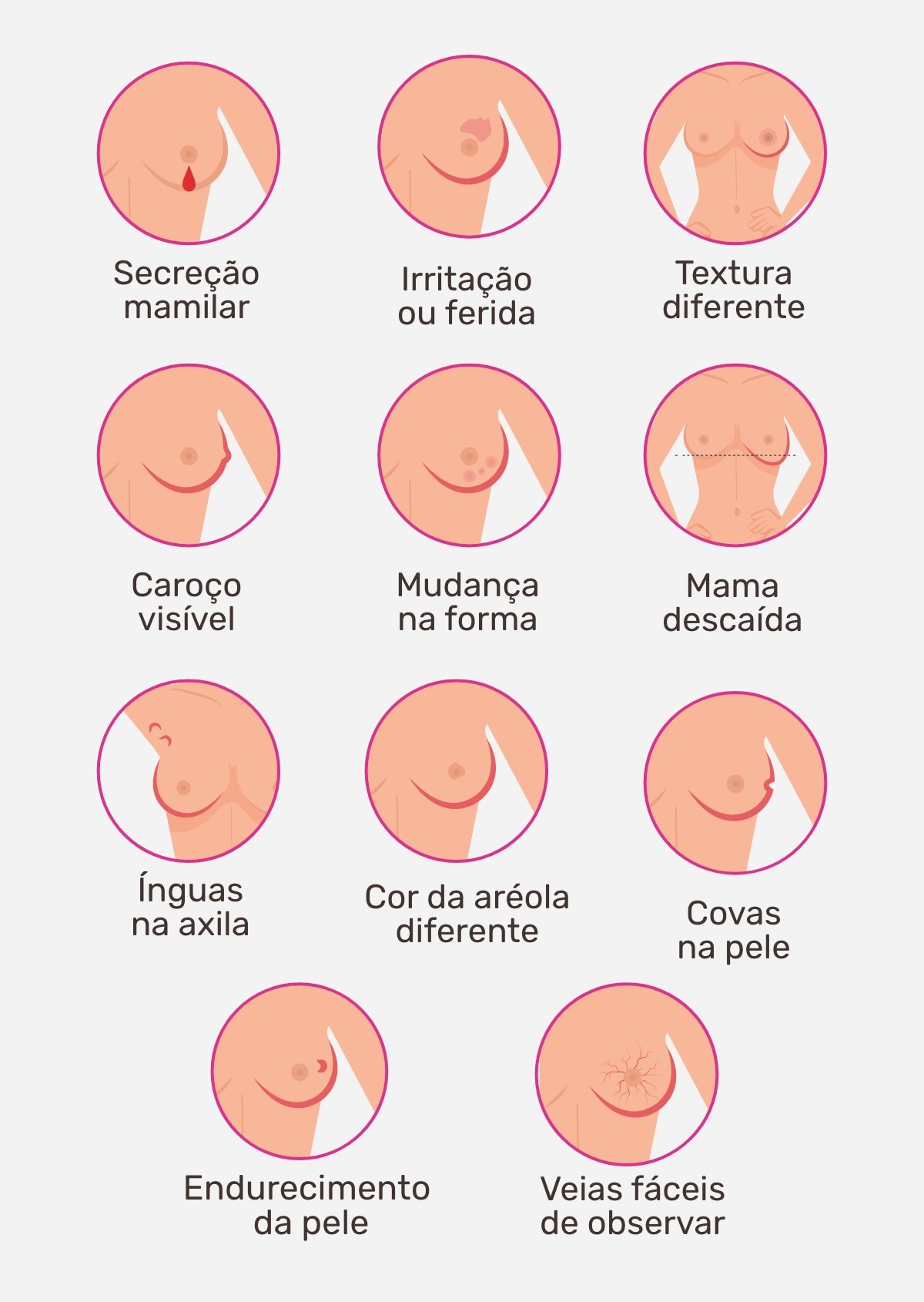
Online symptom test
To find out your risk of breast cancer, select the symptoms presented in the following test:
The symptom test is a tool that only serves as guidance, not serving as a diagnosis or replacing a consultation with a breast specialist.
Symptoms of breast cancer in men
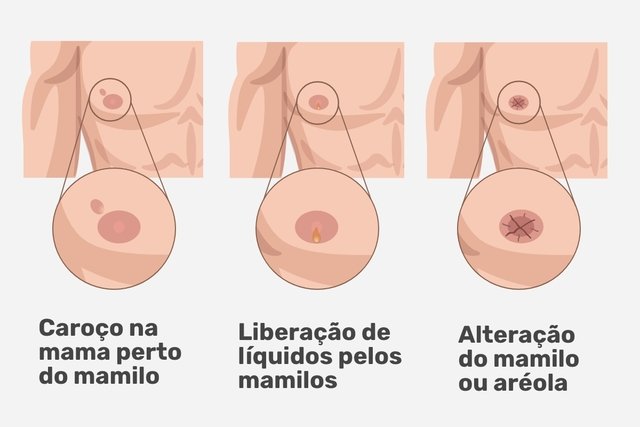
The symptoms of male breast cancer are similar to the symptoms of breast cancer in women, so when there is any type of change in the breast, it is important to consult a mastologist to diagnose the problem and begin appropriate treatment.
Learn about male breast cancer.
Who can get breast cancer
Anyone can develop breast cancer, whether male or female, and people with:
- Age greater than 50 years;
- Family history of breast cancer;
- Obesity and sedentary lifestyle;
Furthermore, there are also genetic changes that can increase the tendency to develop this type of cancer, such as those that occur in the BRCA1 and BRCA2 genes. However, there are tests that can be done and that help identify the change even before cancer appears, giving the opportunity to prevent cancer.
See how this type of genetic test is performed and how it can help prevent breast cancer.
Main types of breast cancer
There are several different types of breast cancer, depending on its development, with some being more aggressive than others. The main ones are:
- Carcinoma ductal on site (CDIS): it is a type of breast cancer in its early stages that develops in the ducts and, therefore, has a high chance of being cured;
- Carcinoma lobular on site (CLIS): it is the second most common type in women and is also in its initial phase, but is located in the milk-producing glands. This type is not very aggressive and easy to treat;
- Invasive ductal carcinoma (IDC): it is the most common type of breast cancer and means that it is at a more advanced stage in which the cancer started in the milk-producing gland, but has spread outside, potentially creating metastases;
- Invasive lobular carcinoma (CLI): It is rarer and often more difficult to identify. This type of cancer may also be related to the emergence of ovarian cancer;
- Inflammatory breast carcinoma: It is an aggressive cancer, but very rare.
In addition to these types of breast cancer, there are also others that are even rarer, such as medullary carcinoma, mucinous carcinoma, tubular carcinoma or malignant phyllodes tumor.
How to identify advanced breast cancer
Symptoms of advanced malignant breast cancer include, in addition to worsening symptoms and lesions in the breast, other signs unrelated to the breast, such as nausea, bone pain, loss of appetite, severe headaches and muscle weakness.
Generally, these symptoms are caused by advanced cancer causing metastasis of malignant cells to other organs in the body, such as the lungs and brain, which is why they should be investigated by a mastologist and clinical oncologist as soon as possible. Learn about other causes of discomfort or pain in the breasts.
How to prevent breast cancer
Preventing breast cancer is achieved by adopting a healthy lifestyle. Therefore, it is recommended to have a healthy diet, with fruits and vegetables, practice regular physical exercise, avoid excessive consumption of alcoholic beverages and eliminate smoking.
However, to effectively prevent this cancer, it is necessary to undergo regular mammograms. Ideally, mammography should be done annually, starting at age 40, according to the Brazilian Society of Mastology and the American Society of Radiology. The Ministry of Health in Brazil, as well as several European mastology medical societies, advise mammograms from the age of 50, twice a year. Women with risk factors for breast cancer, such as first-degree relatives with breast or ovarian cancer under the age of 50, should be screened 10 years before the first case in the family.
In addition, it is also important to perform a monthly breast self-examination, 3 to 5 days after the end of menstruation. The importance of self-examination is always recalled in the government’s annual campaigns, known as Pink October. Understand the step-by-step instructions on how to perform a breast self-examination correctly.
Bibliography
- CANADIAN CANCER SOCIETY. Breast Cancer: understanding your diagnosis. 2015. Available at: <https://www.cancer.ca/~/media/cancer.ca/CW/publications/Breast%20cancer%20UYD/32064-1-NO.pdf>. Accessed on October 23, 2019
- AMERICAN CANCER SOCIETY. Breast Cancer Early Detection and Diagnosis. 2019. Available at: <https://www.cancer.org/content/dam/CRC/PDF/Public/8579.00.pdf>. Accessed on October 23, 2019
- SOGIMIG. Manual of Gynecology and Obstetrics. 5th ed. Belo Horizonte: Coopmed, 2012. 335-342.
- HIPOLABOR. PINK OCTOBER: DISCOVER 5 TYPES OF BREAST CANCER AND THE MAIN TREATMENTS. Available at: <https://www.hipolabor.com.br/blog/2018/10/25/outubro-rosa-conheca-5-tipos-de-cancer-de-mama-e-os-principais-tratamentos/ >. Accessed on October 23, 2019
- LOWDERMILK, Deitra L. et al. Women’s Health and Obstetric Nursing. 10.ed. Rio de Janeiro: Elsevier, 2013. 214-217.
- GOLDMAN, Lee; SCHAFER, Andrew I. . Goldman-Cecil Medicine . 25.ed. Rio de Janeiro: Elsevier, 2018. 1378.

Sign up for our newsletter and stay up to date with exclusive news
that can transform your routine!
Warning: Undefined array key "title" in /home/storelat/public_html/wp-content/plugins/link-whisper-premium/templates/frontend/related-posts.php on line 12
Warning: Undefined array key "title_tag" in /home/storelat/public_html/wp-content/plugins/link-whisper-premium/templates/frontend/related-posts.php on line 13

